
The heart of the system. A cylindrical membrane filters water at a molecular level so only pure water remains. This one produces over 900 litres (200 gallons) a day.
Watermaker
Having a watermaker on board not only allows a cruising yacht to be totally self-sufficient by carrying its very own ‘well’, it also guarantees the water quality. Although the hardware is complex and requires regular cleaning and maintenance, it also brings some unexpected benefits.
Sea water normally has a salinity of 35g of dissolved salts per kilogram of water, so it can cause harm – and even death – if consumed in significant quantities. This is because its salt concentration upsets the delicate osmotic balance of the cells in the human gut. However, sea water can still be used for cooking some types of vegetable and fish on board, which helps to extend a boat’s fresh water supply, so a yacht’s galley will often have a salt water tap over the sink.
To remove the salt from water (and a host of other contaminants), watermakers work on a process called reverse osmosis (RO). Sea water is sucked on board, passed through a series of pre-filters, and then pumped at high pressure (often around 800psi) through a microscopically porous membrane. This membrane is so fine that only the tiny H2O molecules can pass through. Almost everything else, including dissolved elements of sodium, chlorine, calcium, sulphates and potassium along with a legion of bacteria, are all stopped by the membrane and flushed away as waste. The end result is very pure water, which is available at the touch of a button. Advances in technology have turned watermakers into a reliable piece of kit, with models ranging from simple hand pump survival units producing a mouthful every ten minutes to large, built-in devices capable of creating large quantities of water in a day.

The heart of the system. A cylindrical membrane filters water at a molecular level so only pure water remains. This one produces over 900 litres (200 gallons) a day.

Being able to make almost unlimited fresh water from the surrounding sea greatly enhances a yacht’s self-sufficiency.

Water intake and pre-filters. A low-pressure pump draws in sea water and pushes it through a series of increasingly fine filters.
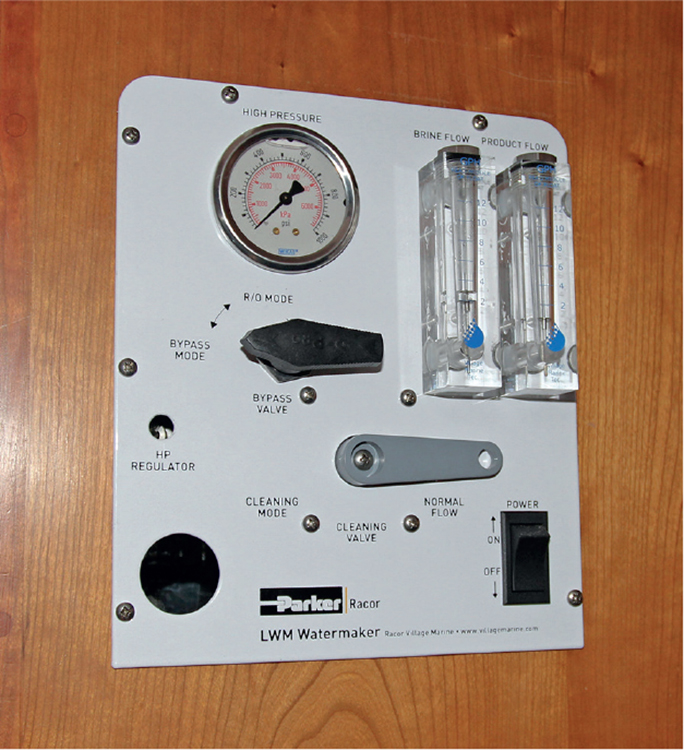
The controller, tucked away in the aft cabin of this yacht, allows the system to be monitored with ‘at-a-glance’ sight gauges for product and waste flow.
Watermakers, however, remain expensive and demand a lot of electrical or mechanical power. They also require regular use and a diligent maintenance programme. In return they offer complete freedom in terms of a yacht’s potable water supply. For many, this self-sufficiency is priceless.
Reasons for fitting a watermaker
 Reduces weight: Water weighs 1kg per litre (10lb per gallon), so by making your own water on board there is no need to fit extra large tanks, or carry heavy jerrycans filled from the quayside tap. Smaller tanks mean a lighter and faster boat.
Reduces weight: Water weighs 1kg per litre (10lb per gallon), so by making your own water on board there is no need to fit extra large tanks, or carry heavy jerrycans filled from the quayside tap. Smaller tanks mean a lighter and faster boat.
 Provides good quality water: Potable water in some parts of the world can be suspect at best. The watermaker produces only pure water, with additional UV safeguards against any viruses small enough to beat the membrane.
Provides good quality water: Potable water in some parts of the world can be suspect at best. The watermaker produces only pure water, with additional UV safeguards against any viruses small enough to beat the membrane.
 Extends range: Not being reliant on finding shore supplies or catching rain means the possibilities for exploration are endless. As a precaution, containers to cover the longest leg away from shore supplies should be carried just in case the watermaker fails.
Extends range: Not being reliant on finding shore supplies or catching rain means the possibilities for exploration are endless. As a precaution, containers to cover the longest leg away from shore supplies should be carried just in case the watermaker fails.
 Saves money: In some popular areas, such as the Caribbean, water is very expensive and can make a big dent in the cruising budget. In more remote areas, where only bottled water may be safe to drink, it still has to be sourced, paid for and carried.
Saves money: In some popular areas, such as the Caribbean, water is very expensive and can make a big dent in the cruising budget. In more remote areas, where only bottled water may be safe to drink, it still has to be sourced, paid for and carried.
 High demand: If you have a young family the demand for fresh water may be higher than average. A watermaker means you can run a washing machine, flush the heads with fresh water, have regular showers, and even wash down the anchor chain.
High demand: If you have a young family the demand for fresh water may be higher than average. A watermaker means you can run a washing machine, flush the heads with fresh water, have regular showers, and even wash down the anchor chain.
 Emergency water: If your tanks become contaminated, or a seam splits, the watermaker can keep the crew hydrated until repairs can be made. Small hand-powered units can also be included in a liferaft grab bag.
Emergency water: If your tanks become contaminated, or a seam splits, the watermaker can keep the crew hydrated until repairs can be made. Small hand-powered units can also be included in a liferaft grab bag.
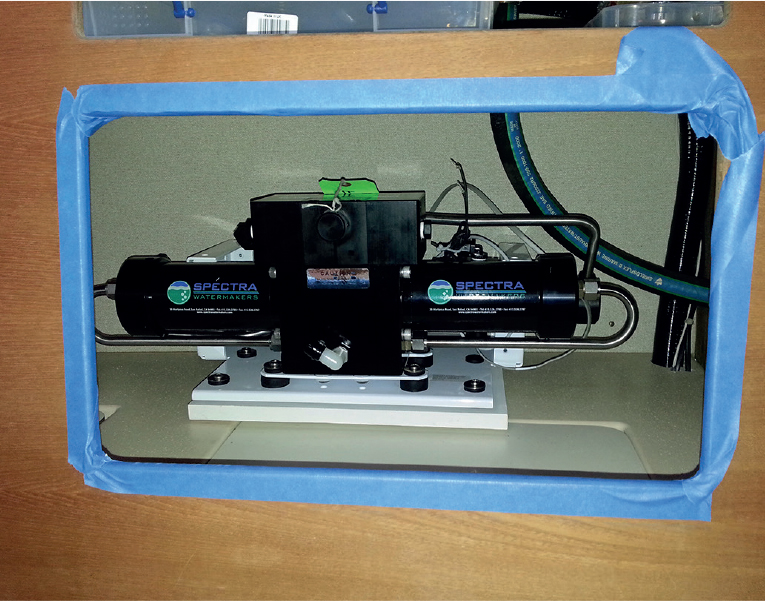
The force behind reverse osmosis comes from the high-pressure pump assembly. This one has an energy recovery unit to increase electrical efficiency.
Choice of watermaker
The choice of commercially available watermakers is huge and they benefit from regular advances in technology. Watermakers can generally be divided into three main types: engine driven, AC powered and hand pumped. The hand-pumped versions are normally found in liferaft grab bags.
Some units are self-contained within an open frame or enclosed cabinet, but tend to be found on larger yachts. Others are modular, allowing the various components to be spread out around a yacht. Each set-up will consist of three main elements; the sea water intake and pre-filters, the high-pressure pump, and the cylindrical membrane assembly with its three connections – one for intake and flushing, one for product and one for brine waste.
The engine-driven versions can also usually be run off the domestic batteries. Some yachts are set up so that a series of solar panels supply enough energy to power the watermaker in hotter climates. Most use an ‘energy recovery’ system for improved efficiency, but rapidly lose performance when the batteries fall below a certain level.
The engine-driven types rely on a high-pressure pump powered by a belt from the engine. However, this depends on there being enough room in the engine bay for the pump assembly to be effectively connected. Watermaking usually coincides with routine battery charging, so an engine-driven system has many advantages.
The AC system versions rely on power from a separate generator set to produce the mains power required. These are usually the most efficient and productive watermakers and are found on larger yachts and charter vessels.
Choosing the right unit
A watermaker is not only a big investment in terms of cash; it will also need a great deal of ongoing maintenance, and a regular supply of pre-filters. It will also be vulnerable to poor sea water quality and oil-based pollution found in some harbours. However, if treated well, the watermaker should produce fresh water for up to five years, meaning the system will more than pay for itself in convenience and savings when cruising in areas limited by availability or poor water quality.
The first choice to make will be capacity. How much water do you want to make, and how much spare electrical power do you have available? The higher the capacity of a watermaker, the greater its cost and complexity and its power demands. The biggest decision will be how much water you need to make on a regular basis, and how much electrical capacity you can spare. It’s also a good idea to choose a proven make with a good distribution network to make the purchase of spares and consumables easier.

The various modules can be placed out of the way in lockers. Here, the main unit is being installed near the galley. Before completion make sure everything can be easily accessed.
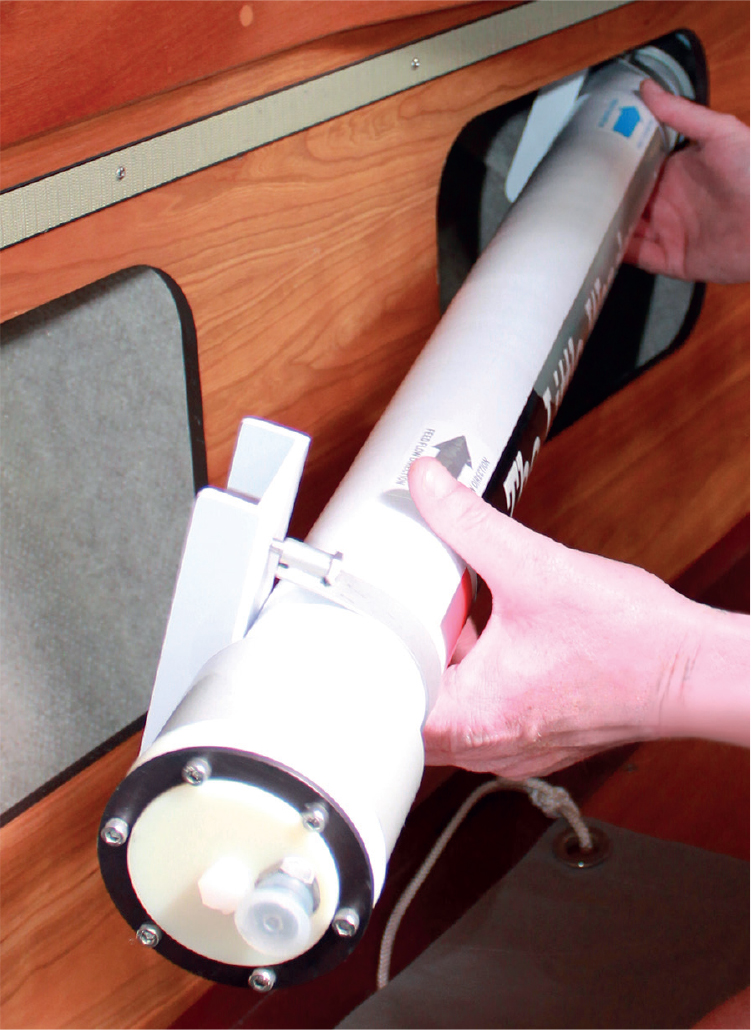
Finding space for the lengthy membrane tube can also prove a challenge, especially as it has to remain accessible.
Undertaking the installation
Having decided on the right unit, the modular design of the smaller units will allow the hardware to be spread out, and many yachtsmen choose to undertake the installation themselves so they can fully understand the system, and position it for the best access for servicing.
The key considerations are:
 Filters will need to be changed often, so will need quick and easy accessibility.
Filters will need to be changed often, so will need quick and easy accessibility.
 Some of the equipment will be noisy, so consider where it can be placed so as not to interfere with sleep.
Some of the equipment will be noisy, so consider where it can be placed so as not to interfere with sleep.
 The waste brine should be discharged overboard above the waterline, making it easy to assess its quality.
The waste brine should be discharged overboard above the waterline, making it easy to assess its quality.
 The intake should be very deep, to avoid air being sucked into the system, and on the opposite side to the toilet discharge.
The intake should be very deep, to avoid air being sucked into the system, and on the opposite side to the toilet discharge.
 Watermakers left unused for a while will need to be ‘pickled’ with acid and alkaline cleaners and run for a while before they can be used again.
Watermakers left unused for a while will need to be ‘pickled’ with acid and alkaline cleaners and run for a while before they can be used again.
 Diverter valves should be in place to allow the system to be flushed through, and for the product to be tested before being put into the tanks. Some systems will do this automatically.
Diverter valves should be in place to allow the system to be flushed through, and for the product to be tested before being put into the tanks. Some systems will do this automatically.
 As an additional virus killer, some sailors add a clear section of pipe from the product take-off that is irradiated with an extra UV light.
As an additional virus killer, some sailors add a clear section of pipe from the product take-off that is irradiated with an extra UV light.
 With a good supply of fresh water available, it can be used more freely. Some yachtsmen have dedicated tanks for the heads or outdoor showers, and keep a separate tank purely for drinking water, sometimes mixed with mineral water.
With a good supply of fresh water available, it can be used more freely. Some yachtsmen have dedicated tanks for the heads or outdoor showers, and keep a separate tank purely for drinking water, sometimes mixed with mineral water.
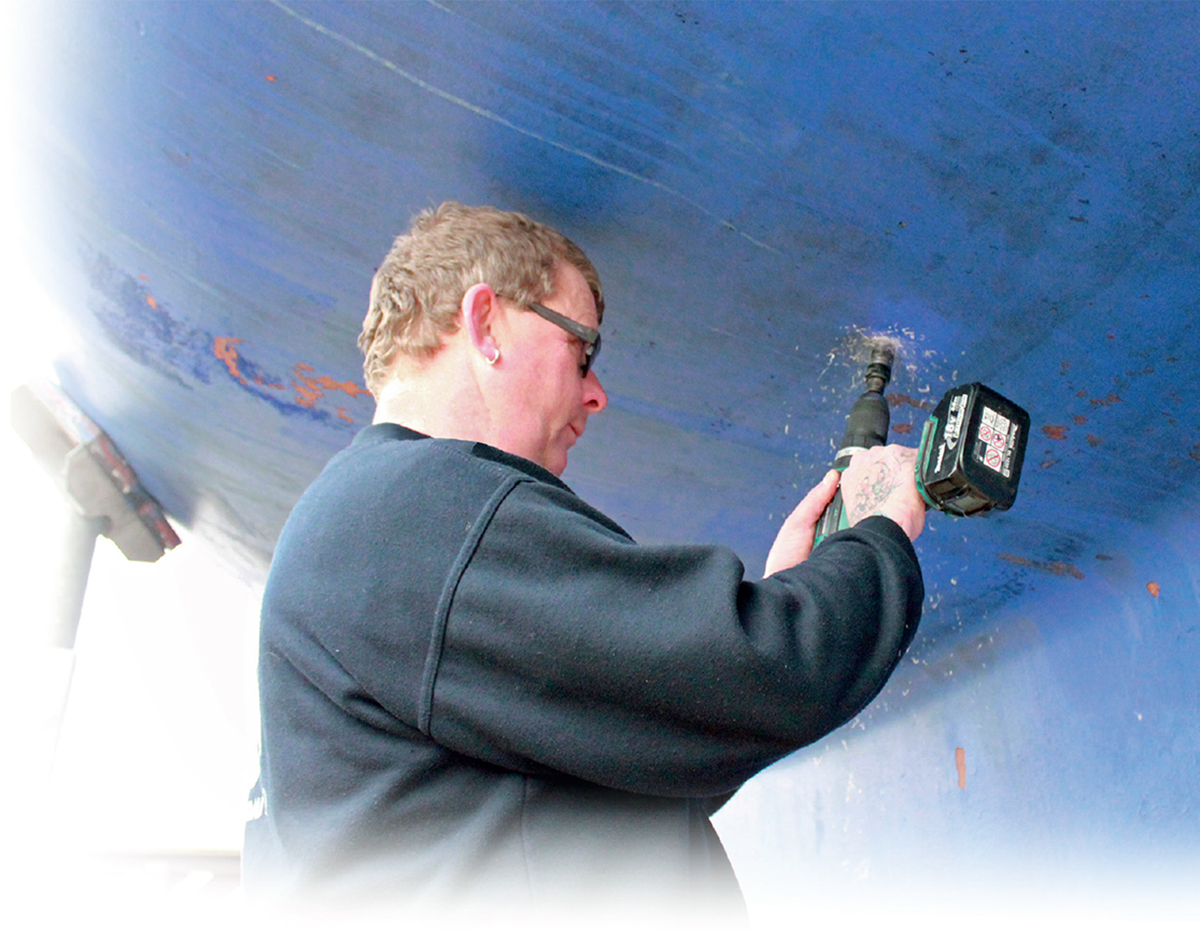
The sea water inlet needs to be as deep as possible to avoid flow interruptions, and on the opposite side from any waste discharges.
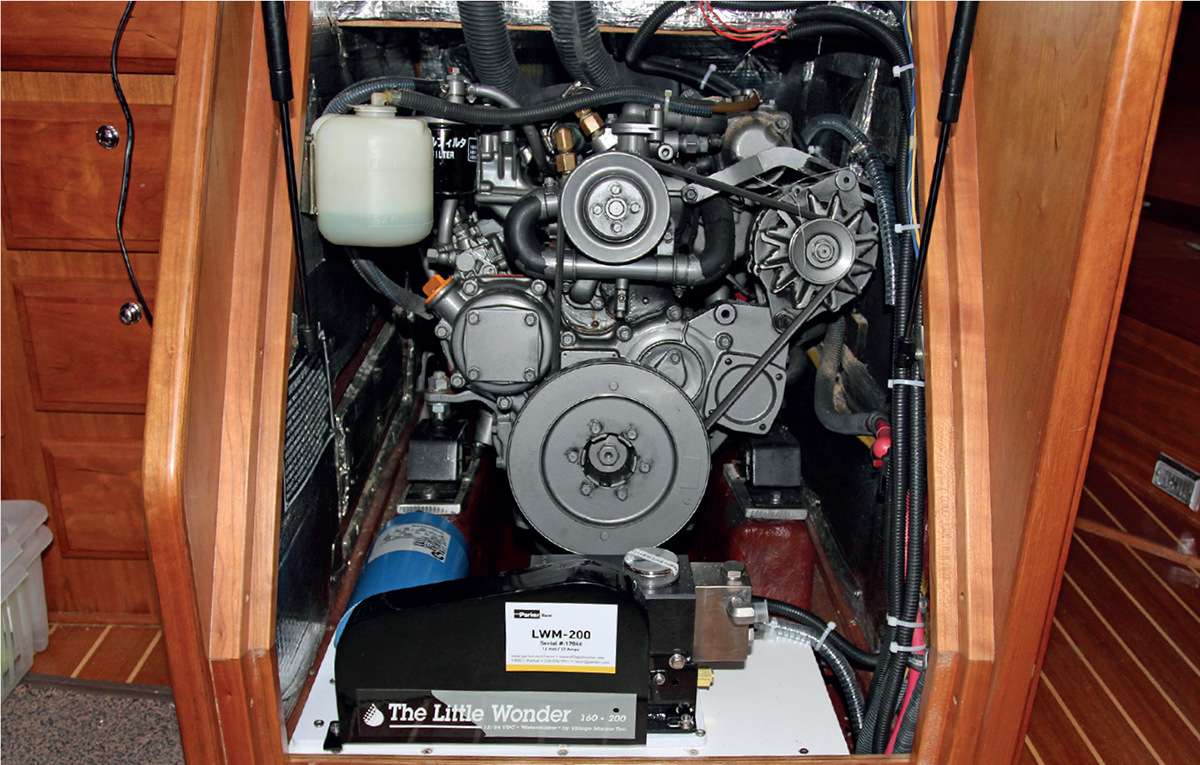
The low-pressure intake pump has been housed in front of the engine. An engine-driven high-pressure pump would need to be belt-connected, which can sometimes prove tricky.